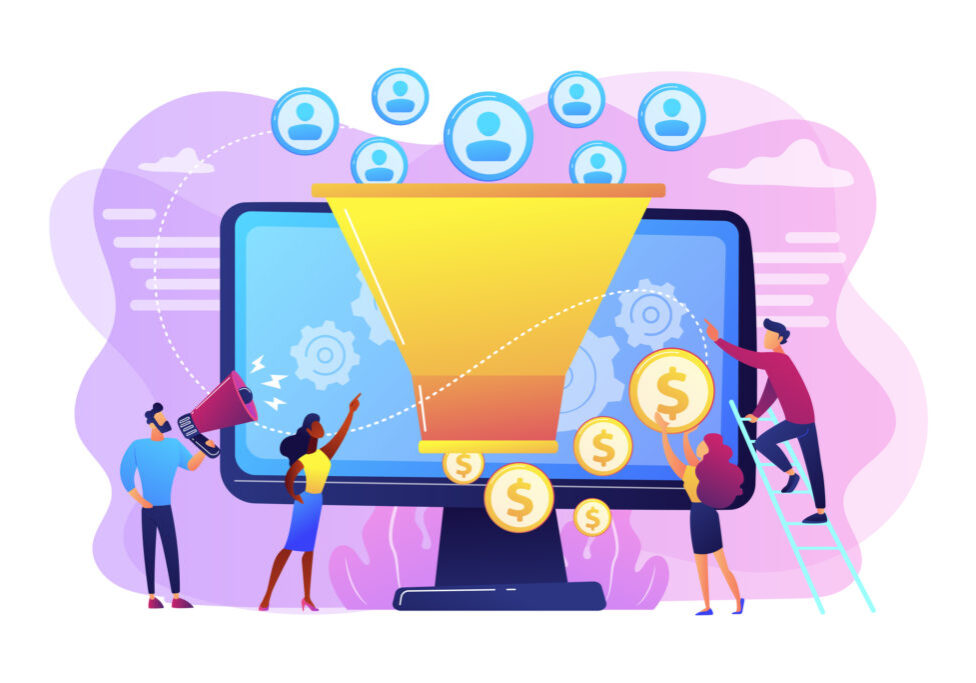You’ve probably heard the term marketing funnel, but maybe had questions about what it was, how to measure it, and most importantly how it can help your business through website analysis. The good news is in this short blog we will answer those questions and give you the tools you need to optimize your marketing. A website analysis is a good first step to improving your digital presence.
The Marketing Funnel is a model for looking at how clients discover and interact with your business. The funnel identifies the path a potential customer travels to a final sale in distinct phases. Let’s take a look at the stages of that path in regards to digital marketing, this will be simplified to four steps due to our tighter focus. These aren’t etched in stone and each business will have some overlap between stages, but the funnel model will help any business visualize how a prospect becomes a sale and how to avoid roadblocks to that process.
Awareness
The client is aware of your goods or service and is informed of your brand. From a digital marketing perspective, this awareness is driven by search marketing. Most often, the main sources of clients to this stage are paid search (Google Ads and Microsoft Advertising), social media (Facebook, Instagram, etc.), and search engine optimization (SEO).
Interest
Prospect shows interest, this could be in a specific product, location, or service. This could be shown by a user visiting a specific page to learn more about a product, returning to your website, following your social media, or filling out a lead form.
Desire
Depending on the goods or service this could be a call, request for more information, or returning to your site. At this point, the client has a good probability of becoming a sale and should be nurtured.
Action
Typically this is a sale, whether it is a good or service. For an e-commerce site, this would be an online sale. For sales that take place offline, it’s important to identify the initial source to know where to most effectively focus your time and money.
Measuring Progress
One of the greatest benefits of digital marketing is the ability to measure customer activity accurately, and monitoring your marketing funnel is no exception. The first tool you should look at is your web analytics.
With Google Analytics the tools are already there to monitor user behavior and visualize the funnel, at least in terms of user behavior on your site. Google calls this the “Goal Funnel” and as you might expect, it starts with a goal. You can define goals for different online activities and then track users from the initial visit to further steps, such as a newsletter signup, through to the actual purchase.
Identify what key goals and action users will take at each step, these can be followed by tracking an action or page view.
With your funnel defined and tracked in Google Analytics, you can track the success of each phase and monitor changes over time.
Optimizing the marketing funnel
Being able to visualize and measure your funnel is just the starting point, the benefit of this is that you can now see user behavior and use that to see what is and isn’t working and how to improve.
Improving awareness
The first step is getting enough qualified users into the funnel. Do you need more website visits? This is where you start.
Are you depending on Google Ads or other PPC advertising to drive traffic to your site? Take a look at your paid ad budget, can you get more targeted traffic at the same cost per visit? Add more keywords, expand your targeted location and experiment with new ads, and calls to action.
Is organic search or social media your main source of traffic? Consider adding more content, offers, and opportunities for engagement. Regular video and written content updates will help build your audience and improve your search engine ranking.
Improving Interest
You’ve got them on your site, how do you turn them into customers? This is where you can start optimizing your site for conversion. What pages are they going to? Are people leaving the site after hitting your landing page? An easy way to see this is by looking at your bounce rate (percentage of people who visit a page and then leave the site). A high bounce rate, over 60%, can indicate you need to examine how conversion-ready your site is. This is a good opportunity to start split testing your landing page. Do you have a welcoming and clear page? Is there a compelling call to action? Testing and optimizing the main landing pages are the key to nurturing interest.
Improving Desire
What are you doing to move the interest forward to action? Is there an offer? Can you sign them up for a newsletter or social media outlet to improve their likelihood of becoming a sale? Testing your follow up messages, offers, and streamlining the customer’s path will improve their likelihood of continuing down the path.
Improving Action
You have a qualified lead that is ready to act, now to close the deal. At this point, you want to make sure there are no artificial barriers to conversion. Experiment with messages to instill a sense of urgency. Can you make a limited time offer or discount? Are there limitations due to your CRM? Too many fields? Issues with billing methods?
Having different people within your organization test these critical pages can reveal issues that the developers may not see.
The Next Steps
Your relationship with customers doesn’t end with the sale. How do you turn new clients into advocates and life long clients? That is a subject for another blog, but with a data-driven approach to your marketing funnel, you have a great start in turning your website into a sales-generating machine.
